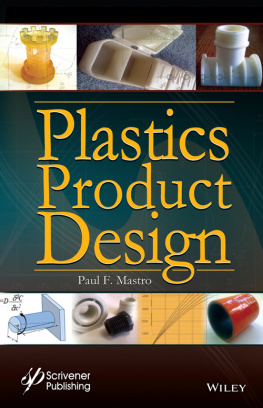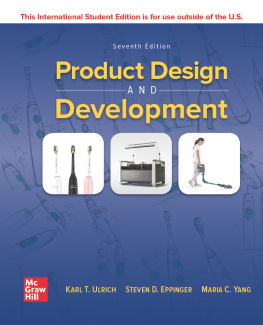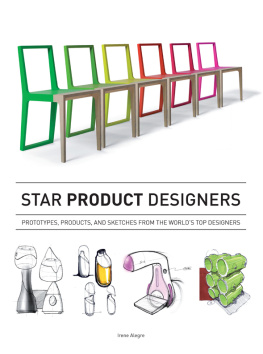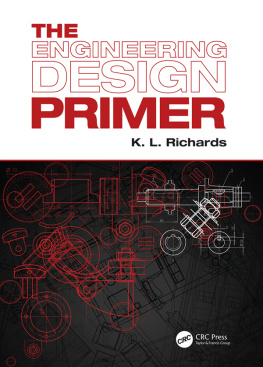Plastics Product Design
Scrivener Publishing
100 Cummings Center, Suite 541J
Beverly, MA 01915-6106
Publishers at Scrivener
Martin Scrivener ()
Phillip Carmical ()
Copyright 2016 by Scrivener Publishing LLC. All rights reserved.
Co-published by John Wiley & Sons, Inc. Hoboken, New Jersey, and Scrivener Publishing LLC, Salem, Massachusetts.
Published simultaneously in Canada.
No part of this publication may be reproduced, stored in a retrieval system, or transmitted in any form or by any means, electronic, mechanical, photocopying, recording, scanning, or otherwise, except as permitted under Section 107 or 108 of the 1976 United States Copyright Act, without either the prior written permission of the Publisher, or authorization through payment of the appropriate per-copy fee to the Copyright Clearance Center, Inc., 222 Rosewood Drive, Danvers, MA 01923, (978) 750-8400, fax (978) 750-4470, or on the web at www.copyright.com . Requests to the Publisher for permission should be addressed to the Permissions Department, John Wiley & Sons, Inc., 111 River Street, Hoboken, NJ 07030, (201) 748-6011, fax (201) 748-6008, or online at http://www.wiley.com/go/permission .
Limit of Liability/Disclaimer of Warranty: While the publisher and author have used their best efforts in preparing this book, they make no representations or warranties with respect to the accuracy or completeness of the contents of this book and specifically disclaim any implied warranties of merchantability or fitness for a particular purpose. No warranty may be created or extended by sales representatives or written sales materials. The advice and strategies contained herein may not be suitable for your situation. You should consult with a professional where appropriate. Neither the publisher nor author shall be liable for any loss of profit or any other commercial damages, including but not limited to special, incidental, consequential, or other damages.
For general information on our other products and services or for technical support, please contact our Customer Care Department within the United States at (800) 762-2974, outside the United States at (317) 572-3993 or fax (317) 572-4002.
Wiley also publishes its books in a variety of electronic formats. Some content that appears in print may not be available in electronic formats. For more information about Wiley products, visit our web site at www.wiley.com .
For more information about Scrivener products please visit www.scrivenerpublishing.com .
Library of Congress Cataloging-in-Publication Data:
ISBN 978-1-118-84271-3
Preface
My first job as a plastics engineer fresh out of college was working for a large custom molder. That gave me a wonderful opportunity to be involved in the design and manufacture of a wide array of different products spanning a number of different industries. What that experience taught me was that in the myriad of different products that I got to work on, the basic engineering principles were the same, but each different industry or product group had constraints and requirements unique to them and often used very specialized engineering techniques that one would not necessarily be aware of if they did have experience in that industry. Working on different products every day gave me an appreciation for how important this knowledge was and how difficult it could be to quickly acquire it. This was reinforced throughout my career as I worked in engineering and product design in a number of different industries. The main purpose of this book is to convey the knowledge I obtained in all of these experiences to help facilitate the design process for people involved in designing or manufacturing similar kinds of parts.
Plastic materials provide the design engineer a wide variety and ever increasing number of possible solutions to some of the most difficult design problems for an ever widening scope of applications. The purpose of this book is to provide the reader with a basic understanding of the range of plastics materials, properties, and processes available to them and an understanding of how to design a variety of basic components from plastic materials.
While the basic design principles that will be discussed in the first section of the book are applicable to the design of any plastic part, each product type or industry has specific or unique requirements, many of which will be discussed in detail in the chapters in part two that should help someone unfamiliar with them to begin to develop a part design.
This book is intended for use by designers who have had limited or no experience with plastics materials as well as a more experienced designer who is designing a part for a use, process or an application that they are not familiar with. Also, the book has an extensive discussion of materials and processes that will provide a solid introduction to plastics for anyone.
In Section 1, Plastics as a Design Material, the reader is provided with an introduction to plastics as a design material. The section is introduced with a brief history of the plastics industry and a discussion of general plastics material properties. The next two chapters will give an overview of the plastics materials commonly in use today and a discussion of a variety of processes available to the designer to make a part along with the design considerations each process will entail. This section also includes a discussion of useful prototyping processes, including advantages and disadvantages of each. Finally, chapter 5 will discuss general design considerations that are applicable to most plastics product designs.
In Section 2, Plastics Product Design, the discussion will turn to the specific design and manufacturing requirements for a number of different product types and components. This section starts with an introduction to plastic materials being used as structural components, where many basic mechanical engineering principles are reviewed as well as a discussion of how they need to be adapted to account for the viscoeleastic behaviour of plastics materials. Chapters follow on enclosures, packaging, gears, hinges, bearings, snap fits, pressure vessels, including pipe, and optical components. These sections will discuss the general considerations that are relevant to these applications as well as specific insights about each particular application. Discussions of plastic joining techniques that are applicable across all product groups will layout the design choices available for putting these components together. The book concludes with a discussion of the product development process and role of the past design and designer in this process.
This book is the result of my experiences as a design and manufacturing engineer and is intended to provide the reader with a basic understanding of plastics materials and processes and to provide a resource to assist them with the design of a number of different components.
I would like to thank my wife Lois for her help and support throughout my career and in this endeavour.
PART 1
PLASTICS AS A DESIGN MATERIAL
Plastics materials have a number of unique properties that allow a wide variety of solutions to many design problems. The nature of some of these properties requires the designer to approach the application of these materials to a product design a little differently than many traditional design materials. This section will review common materials and processes and look at some of the general engineering approaches that need to be taken in developing a plastic product design.









